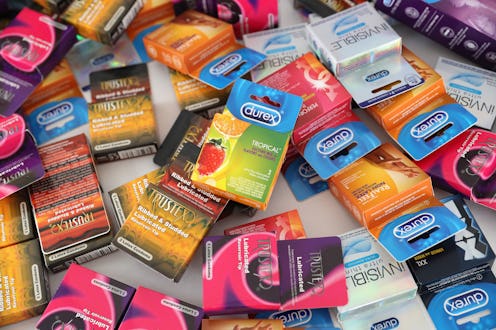News
What You Don't Know About Condoms
Happy Valentine's Day, you sexy thangs. Since it's estimated that about 85 percent of men and women think sex is an important part of Valentine's Day — and 87 condoms are used per second on the day — there's a good chance you're expecting to get lucky if you're in a relationship. (For all my fellow single ladies out there, stuffing your face with loaded barbecue chicken nuggets nachos sounds pretty amazing too.)
But seriously, if you want to get up close and personal on Valentine's Day, Planned Parenthood wants to make sure you stay protected. The organization is raising awareness of sexually transmitted diseases during National Condom Week from Feb. 14-21.
It’s important to remember that no matter what our age, we could still be at risk for a sexually transmitted infection, Planned Parenthood Federation of America vice president of education Leslie Kantor said in a statement.
The truth is that condoms can actually make sex more fun and relaxed because you don’t have to worry about STIs or unintended pregnancy. Consistent condom use helps protect your health and well-being — no matter how old you are or where you are in life.
#Truth.
Using condoms greatly diminishes your chances of contracting HIV, making sex 10,000 times safer, according to Planned Parenthood. Only 19 percent of women ages 20-44 (and just six percent of women 61 and older) use condoms whenever they have sex. Since the U.S. is expected to spend more than $18.6 billion this Valentine's Day, the least you could do is pick up a pack of condoms while buying that last-minute box of chocolates. Even the U.S. government is investing in rubbers: it will spend $244,000 on a study to improve custom-fit condoms.
Condoms are actually pretty cool, scientifically and historically. Here's what you should know about them:
Early Condoms Were Made of Intestines
Sounds appealing. Rumor has it that ancient Egyptians used condoms and dyed them different colors, but the oldest known surviving condom dates back to Sweden in the 1640s. It was made of pig intestine and dipped in warm milk beforehand to kill any microbes. In fact, sheepskin condoms today are still made of intestinal linings. Tasty.
Other condoms were made of animal bladders and tortoise shells (ouch?). In the 16th century, Italian physician Gabriele Falloppio (of Fallopian tube fame) fashioned condoms made of linen and a handy ribbon to keep it in place.
You Can Thank The Goodyear Guy For Condoms
Fast-forward to 1839, the year when Charles Goodyear discovered vulcanization, the treatment that made rubber more pliable. He didn't know it, but he had just made strides in sex history. There was still a ways to go, though, because early rubber condoms were bulky and usually had to be specially fitted by a doctor (awkward).
In 1919, Frederick Killian started using liquid latex molds, and the modern condom was born.
Condoms Are Good For You
Well, duh, we already know that condoms are cheap, convenient, and safeguard people against HIV, STIs, and cervical cancer. But studies suggest that condoms are also beneficial in balancing your vagina's natural pH and protecting against bacterial infections. As Bustle reported:
Researchers in China found that sexually active women who had sex with condoms regularly had greater numbers of beneficial bacteria and microbes in their vaginas, when compared with women who did not use condoms. The study from Beijing Friendship Hospital looked at 164 married women in good health, from ages 18 to 45. Seventy-two of them were using condoms, 57 were using an IUD, and 35 were using the rhythm method. The group of women who were using condoms were found to have higher levels of lactobacillus, the bacteria that can help the vagina maintain optimal pH and protect against infections like bacterial vaginosis.
Sex Ed Fails to Teach Kids How to Use Condoms
It's a touchy subject. According to Planned Parenthood, only about 40 percent of American teens are taught how to apply a condom correctly in health classes. Last year, when the American Academy of Pediatrics updated its guidelines to suggest that condoms should be made readily available to students in school, some people got a little testy about the whole banana in the room. Even though this is a debate that won't die anytime soon, there is no connection between sex ed and increased promiscuity.
The Future of Condoms is a Little Funky
When the Bill & Melinda Gates Foundation announced in 2013 that it will award $1 million for a new condom design, inventors got excited. Condoms are made of latex, polyurethane, lamb skin, and polyisoprene — but there could very well be beef tendon condoms in the future, if one of the applicants has his way.
The International Business Times breaks down some cool new condom design ideas in the works:
One company in California is building the Origami condom, a collapsible silicone affair that’s designed to create pleasant sensations. Researchers at the University of Washington are working on a high-tech condom that uses nanoscale fibers that could also deliver drugs to protect against STIs or deliver contraceptive benefits.
Images: Getty Images; The Frisky; Wikia; Giphy; Tumblr; The Daily Clog
